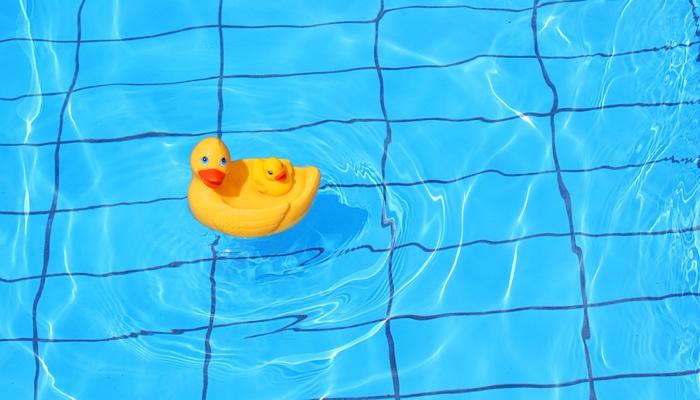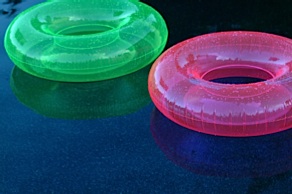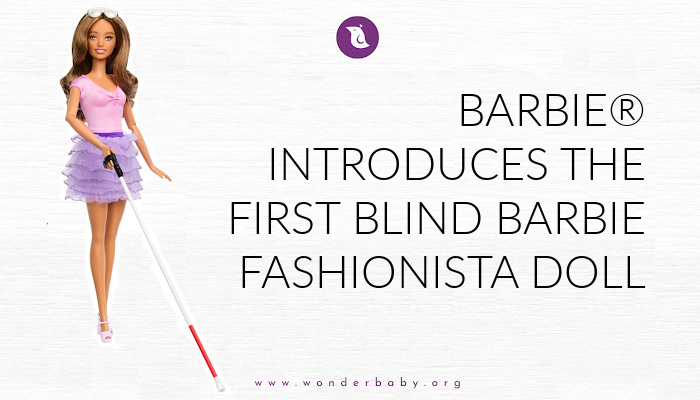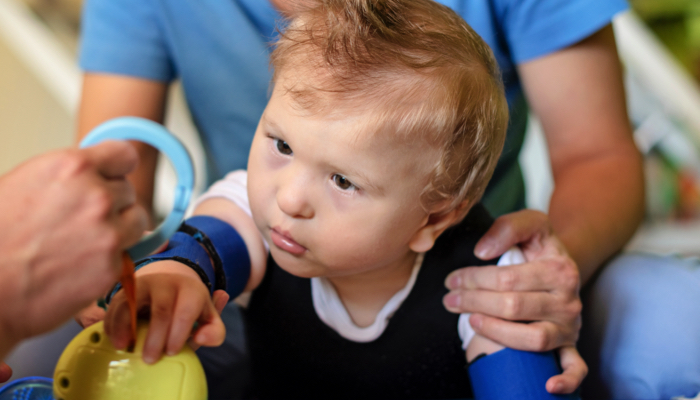Swimming with a Child Who is Visually Impaired

With very little warning and even less preparation some of our local schools’ classes and kindergartens were closed as a containment response to a local outbreak of H1N1.
It was a frightening time for many local parents.
Certainly, we were terrified!
We had a healthy five year old daughter with an unplanned vacation and a hankering for a good time.
We didn’t have the first idea where this good time might be hiding, we just knew it had to be…
- Cool
- Interesting
- Inexpensive
- Mildly educational
- And with relatively low infectivity possibilities!
Our initial thinking was that on Monday we would go to the local public swimming pool—if she enjoys it, great, we can go back. And we haven’t been for ages!
Day One: The Vice-like Grip of Terror
We realized fairly quickly that our idea of it having “been a while” since swimming with Elizabeth was not what her memory was telling her, which ran more along the lines of “I’ve never, ever been here before! What is happening?!”
Her remarks and attitude indicated a mild degree of anxiety, reluctance even, but quickly we were in the pool. She was wearing her spotty red swimsuit and her “brave face” (which was pressed uncomfortably closely to my “encouraging” face). Any suggestions of loosening the choke hold from my neck or her bottom from my knee (which was supporting her) were met with a firm “No, thank you.”
So my partner and I took turns hopping round the pool…for one and a half hours…inconspicuously, we like to think!
At this stage, Elizabeth was terrified and enthralled in almost equal measure. Afterwards, in the changing rooms, we had a difficult job encouraging her into the shower: “But I’ve just been in all that water—I don’t need a shower.”
So we explained that chlorine was added to the pool to keep it clean; that actually the chlorine was what she could smell, and it was a bad idea to leave it on her skin.
Apparently, this was the last straw, the coup de gras, the insult where previously there had only been (mental) injury: “GET IT OFF ME!” she bellowed, charmingly.
Upon later examination, we both had 5-year-old-finger sized bruises on the back of our necks.
But it was a start!
Day Two: “Can We Go Again? Today?”
Later, talking about the experience for Elizabeth with my partner, we agreed that it must have been strange and dreadful for her; possibly rating alongside immunization injections in terms of pleasure derived. So it was a bit of a surprise for us when she jumped out of bed the next morning with one wish, front and center in her mind: “Can we go again? Now?”

We agreed, eventually, to go after lunch. Some time later, when we went to investigate the drumming noise coming from the sitting room, Elizabeth explained to us that she was “practicing swimming” on the floor but it wasn’t working well on account of the sitting room floor remaining uncooperatively solid!
This was a different girl, though—that was self-evident. She now knew what the challenge was; and she intended to give that challenge a good hiding!
Her grip was much less fierce this time—we had decided at the first visit not to do any pretending about her safety, no “jokes” that she might be dropped or dunked. We would be as serious as she was. (And she was deadly serious).
Our approach fully validated itself when we saw the amount of trust she was willing to give us: she plainly did not want to allow us to pull her between us to simulate the movement swimming would give her, or lie on her back with only her head and bottom supported, but she let us do it anyway.
Grimly, she even made her way around the rim of the pool, holding on tightly. (In retrospect this was a lot like the “cruising” she did holding on to furniture, immediately prior to her walking independently.)
Incidentally, I bet the Lifeguards get to see some pretty dopey parents…And at least they were discrete about our failings! With nothing said, one of the female Lifeguards who had taken an interest in Elizabeth’s progress walked away for a few moments and walked back with two inflated arm bands and casually threw them to us.
Well, duh! I wish I’d thought of that! That little bit of additional buoyancy was all that was needed to give our little girl the independence in the water she craved.
Day Three: The Siren Call of the Water Slide!
We decided to take a day off from swimming because Elizabeth was clearly exhausted, although she refused to admit it! That day we endured a million questions :

- Why are there tiles on the floor?
- Why is the floor slippery?
- Why is water a liquid?
- Tell me more about the chlorine I can smell.
- Why do we need to shut the door when we are getting changed? (And what a huge question that is!)
Armed with the best we could do by way of answers, day three saw the introduction of a different girl again: She had a new two-piece swimsuit, she had the confidence now to smile, to hold onto the side and kick her legs and, most significantly of all, to mention the water slide, which she had known was there although she had not mentioned it before.
It must have seemed like a silent, ominous dare to her. So, having secured enough assurances to satisfy her that she would be caught, absolutely and without a doubt, she climbed the stairs of the four-foot slide.
There was no fun here; she had watched and heard other children scream with joy and delight on the slide, but this was something she felt she had to do—and, of course, we put no pressure on her to do it; we just tried to be positively supportive of her attempt regardless of the outcome.
She hit the water like a bomb had gone off!
Once I had cleared her hair and her eyes and her nose, we could see the utter joy in her huge smile—she had beaten the challenge she had set for herself and her pride in her accomplishment was shining out of her!
But she wasn’t finished yet; “I want to swim underneath” she told us. She threw herself beneath the surface of the pool with the cheerful abandon of an inept seal. Every attempt to “swim underwater” (and we couldn’t get her to stop attempting) ended in her swallowing pool water, choking and spluttering; she just could not get the concept of closing her mouth and not breathing. (After a lot of thought, we found a solution; we asked her to do something that would be incompatible with opening her mouth and trying to breathe underwater—we asked her to hum! And it worked! As she goes under now she presses her lips together tightly and begins to hum “Hmmmmm” until she is back up. The air being forced from between her lips prevents her from swallowing water.)
She was chilled, shivering and ready to collapse into sleep, but she (and we) were radiant with pride on the journey home!
Day Four: “Don’t Catch Me!”

“If I don’t say anything, don’t catch me.”
We were not quite sure we had heard right, so I was at the bottom of the slide saying “do you want me to catch you?” and she was at the top of the slide saying nothing at all!
What was I to do?
I didn’t catch her!!!
She emerged triumphant and when she could finally breathe again she asked every adult in the pool (all of whom were strangers), “Did you see that?”
Everyone was most impressed (and they were all very graceful about being asked half a dozen times each if they had indeed witnessed the beauty, bravery and ultra-mega-splashy mermaidyness that had been her entry into the pool).
And she was searching for more challenges:
- Jumping in from the side ✓ Done that!
- Riding on a parent’s back ✓ Done that!
- Floating on her back ✓ Please! She’s done that!
- Going down the slide head first ✓ I think you know the answer to that one!
And then the same friendly Lifeguard did the same quiet routine; this time with brightly colored, weighted rings. This was harder; the water refraction added to her dire depth vision meant she had to grope in the general area. First of all she did this with her feet and when we mooted the possibility of her cheating, we were firmly told: “It’s not wrong—it’s different.”
And she’s right; and we taught her that! Shame on us!
Of course, we don’t need to be told a third time and we had gotten the picture about pool aids so the goggles and nose clips really helped! And she realized the buoyancy the water-wings gave her were not assisting her dives—so she began diving with only one on!
Update: 07.26.09; “Is that a BIG pool, mummy?”
And in we went.
Reflecting on What We’ve Learned…

Our daughter is the bravest person I know. She has albinism and is registered blind. She also has photophobia which means that sunlight erratically glancing off water at random angles is painful for her.
She had to adapt to an entirely different space and rules. She accepted the distorted sound quality and the vulnerability she feels being wet and walking on a tiled floor.
She has developed her own brand of stroke (flap, flap, kick, kick, kick, splash, laugh, spit out pool water and repeat! She has a lifetime to learn classic moves).
She has even managed to categorize all this as fun—isn’t that outrageous!
She frightens, fascinates and astonishes us in equal amounts. This was not about her blindness or her intellect or any of the thousand other things that, as a group, we, the parents of blind and visually impaired babies and children, consider and adapt for and cope with every hour of the day and often the night, too.
This was about my selfish and unstoppable pride in my child who sets her own goals, meets them to her own timetable and standard, and who judges herself as a person of worth.
I am writing this for her.
Oh, and you may be relieved to learn that my partner and I have agreed that water skiing will never, ever be mentioned within Elizabeth’s hearing! (Or scuba-diving, or Olympic diving, or Air and Sea Rescue; this list’s not complete yet!)
Or Lifeguard…
Read this article in Arabic: حيوا-السيدة-العمياء

Related Posts

Toys, Visual Impairment
Barbie® Introduces the First Blind Barbie Fashionista Doll
Mattel, in partnership with AFB, announced the addition of a blind Barbie doll with white cane and sunglasses.

Eye Conditions and Syndromes, Support, Visual Impairment
Coping with a Diagnosis: Emotional Support for Families with Visually Impaired Children
Families with emotional support are more resilient. Learn how to establish emotional support with peers, professionals, and the community to help your family thrive.

Special Needs, Visual Impairment
Why Early Intervention Is Critical for Blind Children
Children diagnosed with visual processing disorders, low vision, or blindness need specialized treatment. Early intervention programs can help.